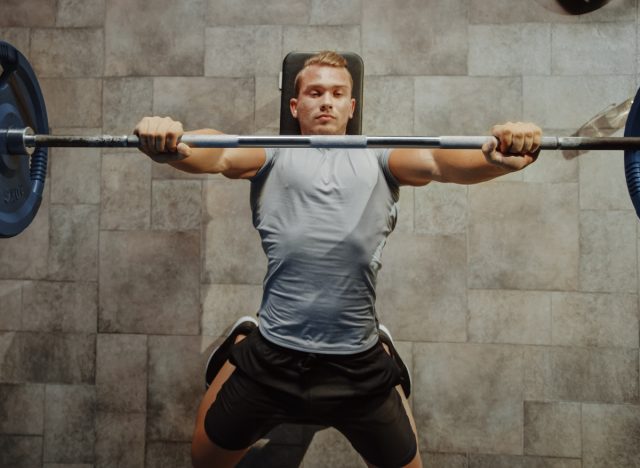If you’ve ever watched a serious lifter grind out a set of half squats or bicep curls that stop midway through, you might have thought, “Hey, you’re supposed to go all the way down!” But hold on—those seemingly incomplete reps aren’t a sign of laziness or bad form. Welcome to the world of partial reps, a training technique that can supercharge muscle strength and growth. You might not be familiar with this method yet, but partial reps are like a secret weapon that adds a unique twist to your workout routine.
Partial reps, also known as “partials,” involve completing only a portion of the full range of motion for an exercise. This method can be used for various reasons, from targeting specific muscle parts to breaking through strength plateaus. While traditional full-range reps are still the gold standard, incorporating partial reps into your routine can create an extra challenge for your muscles, forcing them to adapt and grow stronger.
As a coach with years of experience training clients and athletes, I’ve seen firsthand how partial reps can enhance strength, especially when someone hits a sticking point in their progress. In this article, we’ll dive into what partial reps are, how to perform them correctly, and why they’re a valuable tool for building muscle strength. Whether you’re new to lifting or an experienced gym-goer, partial reps could be the game-changer your workouts need.
What Are Partial Reps?

Partial reps involve performing an exercise through a limited range of motion rather than the full movement. For example, instead of lowering yourself down in a squat, you might stop halfway and come back up. This technique can be used with various exercises, from bench presses and deadlifts to curls and leg presses.
Partial reps aim to overload specific parts of the movement, focusing on where you’re strongest or weakest. This targeted approach can help you target stubborn muscle groups or push through plateaus in your strength training.
For instance, if you struggle with locking out at the top of your bench press, incorporating partial reps in that specific range can help you improve that weak point. Similarly, focusing on the lower half of a squat with partial reps can help build explosive power in your legs.
The science behind partial reps lies in their ability to overload your muscles without increasing the overall load. Since you’re working within a shorter range of motion, your muscles can handle more weight or volume, leading to greater muscle recruitment and strength gains over time. Plus, partial reps allow you to work around fatigue; when your muscles are too tired to perform a full rep, you can still squeeze out a few partials, pushing your muscles to their limits.
How You Perform Partial Reps

Performing partial reps requires intentionality and precision. The key is to select a portion of the range of motion that you want to target. This could be the movement’s bottom, middle, or top, depending on where you’re trying to focus your efforts.
For example, in a squat, you might perform reps in the lower half of the movement to build strength at the point where your legs are under the most tension. Alternatively, in a bicep curl, you might focus on the top half of the movement to work the peak contraction of your biceps.
To perform partial reps effectively, select a weight that allows you to maintain control throughout the movement. Since you’re only working through part of the range of motion, you may be able to lift heavier weights than usual.
However, be cautious—your muscles and joints are under more concentrated stress in a partial rep, so proper form and control are essential to avoid injury. Gradually integrate partial reps into your routine, and remember to pair them with full-range reps to ensure you’re still developing complete muscle function.
You can also perform partial reps at different points during your set. You might start with full-range reps and then transition to partials once you’ve reached fatigue, or you can incorporate partial reps as the focus of a specific workout.
Either way, this technique allows you to push past your typical limits, tapping into new muscle fibers and triggering strength adaptations that you might not get from full-range reps alone.
How Partial Reps Are Important in Helping You Build Muscle Strength

Partial reps are particularly effective for building muscle strength because they allow you to target specific muscle fibers that may not be fully activated during full-range movements. Focusing on a smaller portion of the movement can overload these muscles and create greater tension, encouraging them to adapt and grow stronger.
This method is particularly beneficial when you’re trying to overcome sticking points—those phases in a lift where you tend to get stuck or struggle. Partial reps can help you push through these plateaus by strengthening the muscle groups involved in that specific range of motion.
Another advantage of partial reps is their ability to develop positional strength, especially in phases of movements that require more attention. For example, in a bench press, lifters often struggle with the “lockout” phase—the last few inches before fully extending the arms. Partial reps, focusing on this phase, can build the strength necessary to push past that sticking point.
Similarly, deadlifts and squats have sticking points that can benefit from partial reps. By isolating these challenging sections, partial reps help increase force production where it’s needed most, improving overall performance in the lift.
From a physiological standpoint, partial reps enhance strength by increasing time under tension (TUT), which refers to how long your muscles are engaged during a set. Since partial reps isolate specific phases of a lift, your muscles sustain tension for longer periods within that range of motion, improving muscle endurance and strength over time.
Additionally, partial reps stimulate your central nervous system (CNS) by requiring maximum effort in a shortened range, helping your body adapt to handling heavier loads.
Ultimately, partial reps are a powerful tool in your strength-building arsenal, helping you break through plateaus and optimize your performance in full-range lifts.









